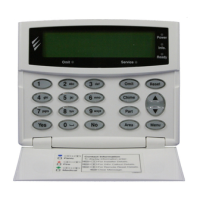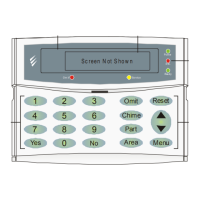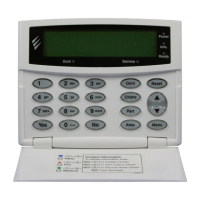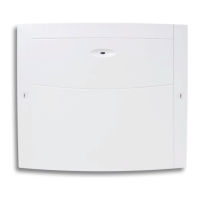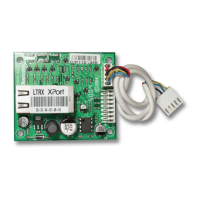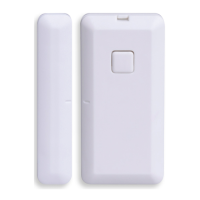Premier 412/816/832 Installation Manual Programming the Control Panel
INS159-13 53
Each telephone number can be up to 24 digits. When entering the
telephone number the following keys can be used:
Press B to insert a “*”.
Press B to insert a “#”.
Press B to insert a “,” (3 second pause).
Press B to insert a “W” (10 second pause).
Press B to insert a “D” (Wait for dial tone).
Press B to insert a “+” (Force dials next number).
Account Numbers -
Alarm Receiving Centre 1 has four account numbers. Account No 1
is for partition 1 and is also the global account number. Account
numbers 2 - 4 are for partitions 2 - 4. To send events on separate
account numbers, you must ensure the “Disable Separate Events
for Each Partition” is turned off (see Protocol Options on page 55).
The account number can be up to 6 digits. Seperate partition
account numbers can be selected by pressing the key. When
entering the account number the following keys can be used to
insert hexadecimal characters:
Press B to insert a “B”.
Press B to insert a “C”.
Press B to insert a “D”.
Press B to insert a “E”.
Press B to insert a “F”.
Press B to insert a “A”.
Protocol Type -
This is the reporting protocol that is used to communicate with
Alarm Receiving Centre 1. The following protocols are supported:
Disabled
Communication disabled.
Pulse Format
The panel will communicate with Alarm Receiving Centre 1 using
Pulse Format. See page 62 for details on configuring reporting
codes.
Express Format
The panel will communicate with Alarm Receiving Centre 1 using
Express Format. See page 62 for details on configuring reporting
codes.
Fast Format/Speech Module
The panel will communicate with Alarm Receiving Centre 1 using
Fast Format protocol. If the “Enable Speech Module” option is
enabled in the Protocol Options (see page 55) the panel will use the
plug-on Speech Module to communicate the alarm information. The
Fast Format/Speech channels must be programmed to the required
to type, see Program Outputs on page 47.
Contact ID
The panel will communicate with Alarm Receiving Centre 1 using
Contact ID. The defaults Contact ID codes are shown in the
standard defaults worksheets from page 86.
SIA Level 2/3
The panel will communicate with Alarm Receiving Centre 1 using
SIA Level 2. If the “Send SIA Text” option is enabled, the panel will
communicate using SIA level 3. The defaults SIA codes are shown
in defaults worksheets from page 86.
Pager
The panel will communicate to a pager. When using the pager
option the panel transmits the data to the pager using the following
format:
Pager Format = AAAAAA EE
If for example the account number for the site was programmed as
1234 and zone 8 was violated and caused a burglar alarm, the
pager would display 1234 38.
When using the pager option the telephone number will
require a pause after it to make it work properly, see
Telephone Numbers above.
When using the pager option the pager is normally
terminated using either a * or #. This is programmable see
Protocol Options on page 55.
The dial attempts when using the pager option should be
programmed to 1, see Dial Attempts on page 53.
The panel has no way of confirming if the pager was called
successfully which means a “Communication Failure” fault
will never be generated.
The panel will only report the event groups that are selected in the
Reporting Options, see page 54.
Mobile Phone
This protocol can be used to communicate with standard or mobile
phones. When an alarm is activated the panel will dial the
programmed telephone number and play a number of “bleeps”,
which is repeated 10 times, after which the panel will hang-up.
The number of bleeps corresponds to the pulse format code for the
selected event, e.g., if the pulse code for zone 4 alarm is
programmed as “4” the panel will play 4 “bleeps”. See page 62 for
details on configuring reporting codes.
Dial Attempts -
This is the number of times the panel will attempt to communicate
with Alarm Receiving Centre 1.
The maximum number of repeat dialling attempts is limited
to 9. The system will only allow you to enter values between
0 and 9. Setting the value to 0 will disable the communicator
for ARC 1.
Partition Options -
The Partition Options are described as follows:
Report for Partition 1
On: The system will report events for Partition 1 to Alarm
Receiving Centre 1.
Off: The system will not report events for Partition 1.
Report for Partition 2
On: The system will report events for Partition 2 to Alarm
Receiving Centre 1.
Off: The system will not report events for Partition 2.
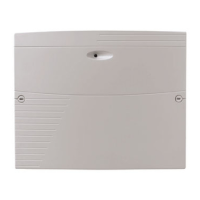
